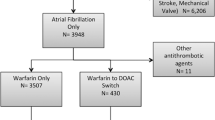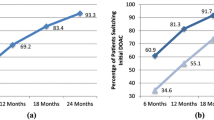Abstract
Purpose
Since 2011, several direct oral anticoagulants (DOACs; dabigatran, rivaroxaban, apixaban) have been introduced as alternatives to warfarin for stroke prophylaxis in atrial fibrillation. We wanted to investigate changes in utilization of oral anticoagulants for atrial fibrillation in Norway following the introduction of DOACs.
Methods
Using nationwide registries, we identified all adults with pharmacy dispensings for warfarin or DOACs between January 2010 and December 2015 in Norway, and used ambulatory reimbursement codes to identify atrial fibrillation as indication. We defined incident use by a 1-year washout period. We describe trends in prevalent and incident use of warfarin and DOACs between 2010 and 2015, as well as patterns of treatment switching for incident users.
Results
One hundred twenty-nine thousand two hundred eighty-five patients filled at least one prescription for an oral anticoagulant for atrial fibrillation; the yearly number of incident users increased from 262 to 421 per 100,000 person-years; and the yearly share of incident users who initiated a DOAC increased to 82%. Half the prevalent users were on a DOAC by 2015. Within a year of drug initiation, 6, 12, 16 and 20% of incident users of apixaban, rivaroxaban, warfarin and dabigatran, respectively, switched oral anticoagulant.
Conclusions
Use of DOACs for anticoagulation in atrial fibrillation became more prevalent between 2010 and 2015 in Norway, at the expense of warfarin.



Similar content being viewed by others
References
Fuster V, Ryden LE, Asinger RW et al (2001) ACC/AHA/ESC guidelines for the management of patients with atrial fibrillation: executive summary: a report of the American College of Cardiology/American Heart Association Task Force on Practice Guidelines and the European Society of Cardiology Committee for Practice Guidelines and Policy Conferences (Committee to Develop Guidelines for the Management of Patients With Atrial Fibrillation) developed in collaboration with the North American Society of Pacing and Electrophysiology. Circulation 104(17):2118–2150
Heeringa J, van der Kuip DA, Hofman A et al (2006) Prevalence, incidence and lifetime risk of atrial fibrillation: the Rotterdam study. Eur Heart J 27(8):949–953. doi:10.1093/eurheartj/ehi825
Zoni-Berisso M, Lercari F, Carazza T, Domenicucci S (2014) Epidemiology of atrial fibrillation: European perspective. Clin Epidemiol 6:213–220. doi:10.2147/CLEP.S47385
Tveit A, Abdelnoor M, Enger S, Smith P (2008) Atrial fibrillation and antithrombotic therapy in a 75-year-old population. Cardiology 109(4):258–262. doi:10.1159/000107789
Angell MS, Tiwari S, Løchen ML (2015) Prevalens og risikofaktorer for selvrapportert atrieflimmer hos menn og kvinner - Tromsøundersøkelsen [Prevalence and risk factors for self-reported atrial fibrillation in men and women—the Tromsø study]. Hjerteforum 28(4):36–42 Norwegian
Go AS, Hylek EM, Phillips KA, Chang Y, Henault LE, Selby JV, Singer DE (2001) Prevalence of diagnosed atrial fibrillation in adults: national implications for rhythm management and stroke prevention: the AnTicoagulation and risk factors in atrial fibrillation (ATRIA) study. JAMA 285(18):2370–2375. doi:10.1001/jama.285.18.2370
Krijthe BP, Kunst A, Benjamin EJ et al (2013) Projections on the number of individuals with atrial fibrillation in the European Union, from 2000 to 2060. Eur Heart J 34(35):2746–2751. doi:10.1093/eurheartj/eht280
Chugh SS, Havmoeller R, Narayanan K et al (2014) Worldwide epidemiology of atrial fibrillation: a global burden of disease 2010 study. Circulation 129(8):837–847. doi:10.1161/CIRCULATIONAHA.113.005119
Wolf PA, Abbott RD, Kannel WB (1991) Atrial fibrillation as an independent risk factor for stroke: the Framingham study. Stroke 22(8):983–988. doi:10.1161/01.STR.22.8.983
Hart RG, Pearce LA, Aguilar MI (2007) Meta-analysis: antithrombotic therapy to prevent stroke in patients who have nonvalvular atrial fibrillation. Ann Intern Med 146(12):857–867. doi:10.7326/0003-4819-146-12-200706190-00007
Ogilvie IM, Newton N, Welner SA, Cowell W, Lip GY (2010) Underuse of oral anticoagulants in atrial fibrillation: a systematic review. Am J Med 123(7):638–645 e634. doi:10.1016/j.amjmed.2009.11.025
Connolly SJ, Ezekowitz MD, Yusuf S et al (2009) Dabigatran versus warfarin in patients with atrial fibrillation. N Engl J Med 361(12):1139–1151. doi:10.1056/NEJMoa0905561
Patel MR, Mahaffey KW, Garg J et al (2011) Rivaroxaban versus warfarin in nonvalvular atrial fibrillation. N Engl J Med 365(10):883–891. doi:10.1056/NEJMoa1009638
Granger CB, Alexander JH, McMurray JJ et al (2011) Apixaban versus warfarin in patients with atrial fibrillation. N Engl J Med 365(11):981–992. doi:10.1056/NEJMoa1107039
Wallentin L, Yusuf S, Ezekowitz MD et al (2010) Efficacy and safety of dabigatran compared with warfarin at different levels of international normalised ratio control for stroke prevention in atrial fibrillation: an analysis of the RE-LY trial. Lancet 376(9745):975–983. doi:10.1016/S0140-6736(10)61194-4
Singer DE, Hellkamp AS, Piccini JP et al (2013) Impact of global geographic region on time in therapeutic range on warfarin anticoagulant therapy: data from the ROCKET AF clinical trial. J Am Heart Assoc 2(1):e000067. doi:10.1161/JAHA.112.000067
Wallentin L, Lopes RD, Hanna M et al (2013) Efficacy and safety of apixaban compared with warfarin at different levels of predicted international normalized ratio control for stroke prevention in atrial fibrillation. Circulation 127(22):2166–2176. doi:10.1161/CIRCULATIONAHA.112.142158
Stollberger C, Finsterer J (2013) Concerns about the use of new oral anticoagulants for stroke prevention in elderly patients with atrial fibrillation. Drugs Aging 30(12):949–958. doi:10.1007/s40266-013-0119-3
Opstelten W, van den Donk M, Kuijpers T, Burgers J (2015) New oral anticoagulants for nonvalvular atrial fibrillation in the elderly: limited applicability in primary care. Eur J Gen Pract 21(2):145–149. doi:10.3109/13814788.2014.989986
Camm AJ, Lip GY, De Caterina R et al (2012) 2012 focused update of the ESC guidelines for the management of atrial fibrillation: an update of the 2010 ESC guidelines for the management of atrial fibrillation—developed with the special contribution of the European Heart Rhythm Association. Europace 14(10):1385–1413. doi:10.1093/europace/eus305
January CT, Wann LS, Alpert JS et al (2014) 2014 AHA/ACC/HRS guideline for the management of patients with atrial fibrillation: a report of the American College of Cardiology/American Heart Association Task Force on Practice Guidelines and the Heart Rhythm Society. J Am Coll Cardiol 64(21):e1–76. doi:10.1016/j.jacc.2014.03.022
Kirchhof P, Benussi S, Kotecha D et al (2016) 2016 ESC guidelines for the management of atrial fibrillation developed in collaboration with EACTS. Eur Heart J 37(38):2893–2962. doi:10.1093/eurheartj/ehw210
Norsk selskap for trombose og hemostase (2013) Retningslinjer for antitrombotisk behandling og profylakse [Norwegian Society of Thrombosis and Haemostasis (2013) Guidelines on antithrombotic therapy and prophylaxis]. MagicApp. https://www.magicapp.org/app#/guideline/1. Accessed 27 June 2017. Norwegian
O'Brien EC, Kim S, Hess PL, Kowey PR, Fonarow GC, Piccini JP, Peterson ED (2015) Effect of the 2014 atrial fibrillation guideline revisions on the proportion of patients recommended for oral anticoagulation. JAMA Intern Med 175(5):848–850. doi:10.1001/jamainternmed.2015.13
Komen J, Forslund T, Hjemdahl P, Andersen M, Wettermark B (2017) Effects of policy interventions on the introduction of novel oral anticoagulants in Stockholm: an interrupted time series analysis. Br J Clin Pharmacol 83(3):642–652. doi:10.1111/bcp.13150
Furu K (2008) Establishment of the nationwide Norwegian Prescription Database (NorPD)—new opportunities for research in pharmacoepidemiology in Norway. Nor J Epidemiol 18(2):129–136
Furu K, Wettermark B, Andersen M, Martikainen JE, Almarsdottir AB, Sorensen HT (2010) The Nordic countries as a cohort for pharmacoepidemiological research. Basic Clin Pharmacol Toxicol 106(2):86–94. doi:10.1111/j.1742-7843.2009.00494.x
World Health Organization (1992) International Statistical Classification of Diseases and Related Health Problem - 10th revision
Wonca International Classification Committee (1998) International Classification of Primary Care - 2nd Edition
Hallas J, Gaist D, Bjerrum L (1997) The waiting time distribution as a graphical approach to epidemiologic measures of drug utilization. Epidemiology 8(6):666–670
Staerk L, Fosbol EL, Gadsboll K et al (2016) Non-vitamin K antagonist oral anticoagulation usage according to age among patients with atrial fibrillation: temporal trends 2011-2015 in Denmark. Sci Rep 6:31477. doi:10.1038/srep31477
Huisman MV, Rothman KJ, Paquette M et al (2017) The changing landscape for stroke prevention in AF: findings from the GLORIA-AF Registry phase 2. J Am Coll Cardiol 69(7):777–785. doi:10.1016/j.jacc.2016.11.061
Pancholy SB, Sharma PS, Pancholy DS, Patel TM, Callans DJ, Marchlinski FE (2014) Meta-analysis of gender differences in residual stroke risk and major bleeding in patients with nonvalvular atrial fibrillation treated with oral anticoagulants. Am J Cardiol 113(3):485–490. doi:10.1016/j.amjcard.2013.10.035
Hellfritzsch M, Husted SE, Grove EL et al (2017) Treatment changes among users of non-vitamin K antagonist oral anticoagulants in atrial fibrillation. Basic Clin Pharmacol Toxicol 120(2):187–194. doi:10.1111/bcpt.12664
Beyer-Westendorf J, Forster K, Ebertz F et al (2015) Drug persistence with rivaroxaban therapy in atrial fibrillation patients-results from the Dresden non-interventional oral anticoagulation registry. Europace 17(4):530–538. doi:10.1093/europace/euu319
Beyer-Westendorf J, Ebertz F, Forster K et al (2015) Effectiveness and safety of dabigatran therapy in daily-care patients with atrial fibrillation. Results from the Dresden NOAC Registry. Thromb Haemost 113(6):1247–1257. doi:10.1160/TH14-11-0954
Heidbuchel H, Verhamme P, Alings M et al (2015) Updated European Heart Rhythm Association practical guide on the use of non-vitamin K antagonist anticoagulants in patients with non-valvular atrial fibrillation. Europace 17(10):1467–1507. doi:10.1093/europace/euv309
Beyer-Westendorf J, Gelbricht V, Forster K et al (2014) Safety of switching from vitamin K antagonists to dabigatran or rivaroxaban in daily care—results from the Dresden NOAC registry. Br J Clin Pharmacol 78(4):908–917. doi:10.1111/bcp.12391
Ramm J (2013) Eldres bruk av helse- og omsorgstjenester [Health and care. Use of services among the elderly]. Stat Anal 137:93–100 Norwegian
Author information
Authors and Affiliations
Contributions
LJK and RS did the analyses. LJK wrote the manuscript. All authors helped plan and design the study, interpret findings and revise the manuscript. All authors approved the final version of the manuscript.
Corresponding author
Ethics declarations
The Regional Committee for Medical and Health Research Ethics in Central Norway approved the study protocol before the study commenced. The Norwegian Data Protection Authority gave a licence to link registry data.
Conflict of interest
The authors declare that they have no conflict of interest.
Electronic supplementary material
Online resource 1
(PDF 171 kb)
Online resource 2
(PDF 166 kb)
Online resource 3
(PDF 166 kb)
Online resource 4
(PDF 175 kb)
Online resource 5
(PDF 532 kb)
Online resource 6
(PDF 174 kb)
Online resource 7
(PDF 171 kb)
Rights and permissions
About this article
Cite this article
Kjerpeseth, L.J., Ellekjær, H., Selmer, R. et al. Trends in use of warfarin and direct oral anticoagulants in atrial fibrillation in Norway, 2010 to 2015. Eur J Clin Pharmacol 73, 1417–1425 (2017). https://doi.org/10.1007/s00228-017-2296-1
Received:
Accepted:
Published:
Issue Date:
DOI: https://doi.org/10.1007/s00228-017-2296-1




